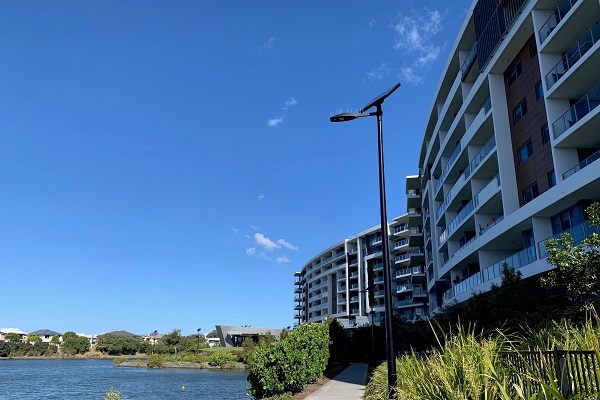The golden rule in solar lighting
‘Power in equals power out’, is the rule that must not be broken with solar lighting. John Warren from Orca Solar Lighting runs through that and more.
Solar street lighting is often used as a generic term for larger overhead solar lighting systems generally mounted on a pole that is four metres or higher.
ADVERTISEMENT
Solar lighting has a range of benefits, as I’ve laid out in this section of Electrical Connection. Some of these include (but are not limited to): lighting minor and main roads, remote highway intersections, car parks, reserves, bike/pathways, marinas, pontoons and jetties.
Additionally, sometimes they are temporary road works, construction with the use of a relocatable concrete block footing or trailer with wheels arrangement.
All these lighting solutions comprise a solar panel, a battery to store the energy, the lighting controller (the brains of the system) that instructs the light to turn on at dusk and off at dawn and the light fitting.
If your lighting requirement is mission critical, such as public infrastructure lighting, industrial, mining and government sites, to ensure a reliable and constant light source, the number one principle is ‘power in equals power out’.
Power in includes solar power yield and power storage capacity. For example, if a 30W, constant all-night light is required all year round and the longest winter nights are 15 hours, then the shortest winter days preceding these longest winter nights, will require 450Wh to run (15 hours x 30W).
Harvesting and storing 450Wh requires a minimum capacity solar panel and minimum capacity battery. This requires a methodology to calculate the minimum solar panel and battery requirement.
Solar radiation data provides robust years (ideally ten-plus) of historical data for any coordinate on the planet. It works on the basis of the solar panel facing the equator (optimum orientation) on either a zero-degree (sub-optimum angle) or the optimum angle from the horizontal (determined by the latitude). This can calculate the solar panel and battery sizing before starting the project, a great tool for electricians working in this space.
There’s also a specialised system sizing tool that takes inputs like peak sunlight hours, night-time length, average and worst-case consecutive ‘dark out days’ as well as the necessary re-rates for performance degradation. This helps calculate the loss of power that happens through performance fluctuation, extreme temperatures, voltage drops and dirty solar panels.
Also, a shading assessment is required to ensure the solar panels receive direct sunlight all day all year round, or the necessary de-rates are allowed for if the solar panel is subject to some shade.
This is the only way to ensure a solar lighting system will provide reliable and constant light all year round. Unfortunately, some solar lighting products violate this most basic ‘power in equals power out’ law.
Integrated (all in one) style solar lights tend to be the biggest culprits, as they are often set to run at the higher wattages of the proper solar lighting systems (which have fully rotating solar panels that can face the equator and be set to the optimum angle from the horizontal to match the latitude). Therefore, integrated solar lights will often have an undersized solar panel facing a sub-optimal direction and on a sub-optimum angle to the horizontal.
This may be satisfactory if the owner of the solar lighting solution is content with seasonal reliability and/or the lights dimming as the often-undersized battery is drained, however for mission-critical lighting, this may be (and should be) deemed unacceptable.
For a potential buyer of solar lights, one way to ensure the prospective solar light is up to the task is to request their solar lighting system sizing calculator summary (Figure 1). Many suppliers will not be able to provide this and may not even be aware of its importance.
Remember this is critical to the integrity of the solar panel and battery sizing. Be sure to clarify what derates and buffers have been allowed for in the calculations.
-
ADVERTISEMENT
-
ADVERTISEMENT


